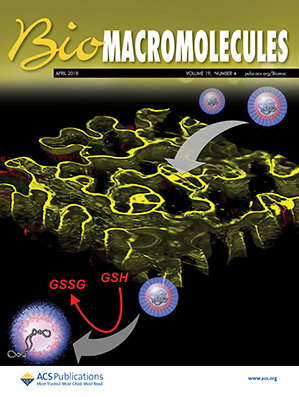用于骨生成和免疫调节的基于光固化细菌Levan的3d生物打印支架。
IF 5.5
2区 化学
Q1 BIOCHEMISTRY & MOLECULAR BIOLOGY
引用次数: 0
摘要
新兴的增材制造技术,如基于容器的三维(3D)生物打印,为制备复杂几何形状的个性化支架提供了新的途径。然而,有必要开发适合临床翻译的生物墨水。本研究探索了细菌来源的甲基丙烯酸酯levan (LeMA)作为骨组织支架数字光处理(DLP) 3D生物打印的生物链接的潜力。LeMA被成功合成,表征,并用于制造3d生物打印支架具有优异的打印性和物理化学性能。体外研究表明,15% w/v的LeMA凝胶比20%的LeMA凝胶具有更好的细胞相容性。15% LeMA凝胶支持成骨分化,证明了碱性磷酸酶活性和MC3T3前成骨细胞的矿物沉积。重要的是,LeMA水凝胶正向调节巨噬细胞表型,促进抗炎标志物CD206的表达。这些发现表明,3d打印LeMA支架可以为骨再生创造良好的微环境,突出了其在组织修复和再生应用方面的潜力。本文章由计算机程序翻译,如有差异,请以英文原文为准。
Vat-Based 3D-Bioprinted Scaffolds from Photocurable Bacterial Levan for Osteogenesis and Immunomodulation
Emerging techniques of additive manufacturing, such as vat-based three-dimensional (3D) bioprinting, offer novel routes to prepare personalized scaffolds of complex geometries. However, there is a need to develop bioinks suitable for clinical translation. This study explored the potential of bacterial-sourced methacrylate levan (LeMA) as a bioink for the digital light processing (DLP) 3D bioprinting of bone tissue scaffolds. LeMA was successfully synthesized, characterized, and used to fabricate 3D-bioprinted scaffolds with excellent printability and physicochemical properties. In vitro studies demonstrated superior cytocompatibility of 15% w/v LeMA gels compared to 20% gels. 15% LeMA gels supported osteogenic differentiation , as evidenced by alkaline phosphatase activity and mineral deposition by MC3T3 pre-osteoblasts. Importantly, the LeMA hydrogels positively modulated the macrophage phenotype, promoting the expression of the anti-inflammatory marker CD206. These findings suggest that 3D-printed LeMA scaffolds can create a favorable microenvironment for bone regeneration, highlighting their potential for tissue repair and regeneration applications.
- Download: Download high-res image (137KB)
- Download: Download full-size image
求助全文
通过发布文献求助,成功后即可免费获取论文全文。
去求助
来源期刊

Biomacromolecules
化学-高分子科学
CiteScore
10.60
自引率
4.80%
发文量
417
审稿时长
1.6 months
期刊介绍:
Biomacromolecules is a leading forum for the dissemination of cutting-edge research at the interface of polymer science and biology. Submissions to Biomacromolecules should contain strong elements of innovation in terms of macromolecular design, synthesis and characterization, or in the application of polymer materials to biology and medicine.
Topics covered by Biomacromolecules include, but are not exclusively limited to: sustainable polymers, polymers based on natural and renewable resources, degradable polymers, polymer conjugates, polymeric drugs, polymers in biocatalysis, biomacromolecular assembly, biomimetic polymers, polymer-biomineral hybrids, biomimetic-polymer processing, polymer recycling, bioactive polymer surfaces, original polymer design for biomedical applications such as immunotherapy, drug delivery, gene delivery, antimicrobial applications, diagnostic imaging and biosensing, polymers in tissue engineering and regenerative medicine, polymeric scaffolds and hydrogels for cell culture and delivery.
 求助内容:
求助内容: 应助结果提醒方式:
应助结果提醒方式:


